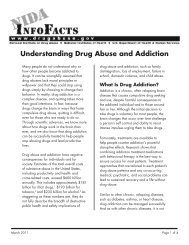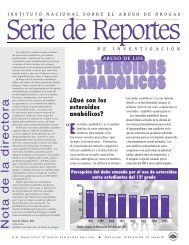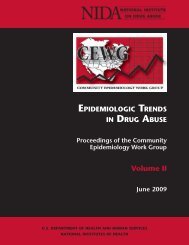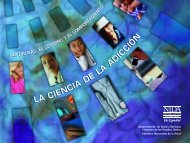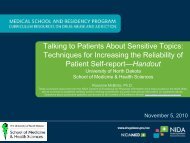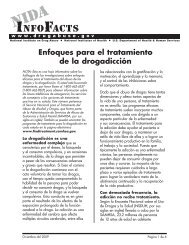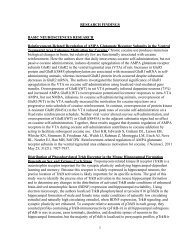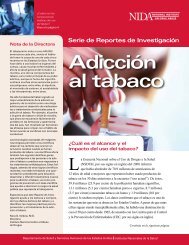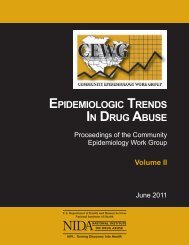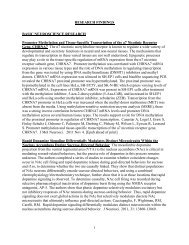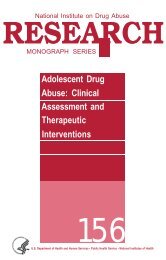CEWG January 09 Full Report - National Institute on Drug Abuse
CEWG January 09 Full Report - National Institute on Drug Abuse
CEWG January 09 Full Report - National Institute on Drug Abuse
Create successful ePaper yourself
Turn your PDF publications into a flip-book with our unique Google optimized e-Paper software.
EpidEmiologic TrEnds in drug AbusE: HigHligHTs And ExEcuTivE summAry<br />
period (CY 2007), Hawai‘i, Los Angeles, Colorado,<br />
San Diego, Phoenix/Maricopa County,<br />
and Texas c<strong>on</strong>tinued to report declines in the<br />
first half of 2008. In Phoenix, the area representative<br />
reported that some anecdotal evidence<br />
may indicate that the methamphetamine supply<br />
is beginning to turn upward again. In additi<strong>on</strong>,<br />
methamphetamine indicators were leveling off<br />
or declining slightly in Seattle, stable or declining<br />
in the Denver/Boulder area, and declining<br />
in San Francisco. Indicators (including overdose<br />
deaths, arrestee prevalence, treatment<br />
admissi<strong>on</strong>s, and drug items identified n forensic<br />
laboratories) were down in San Diego, after<br />
peaking in 2005. The <str<strong>on</strong>g>CEWG</str<strong>on</strong>g> representative<br />
reported that methamphetamine has become<br />
less available and of lower quality with increased<br />
prices since 2005 in San Diego County, based<br />
<strong>on</strong> survey data. In Albuquerque, methamphetamine<br />
indicators were reported as stable and as<br />
increasing slightly in New Mexico.<br />
• In the midwestern regi<strong>on</strong>, methamphetamine<br />
indicators were reported as decreasing in the<br />
Minneapolis/St. Paul reporting area (figure 9),<br />
as stable or decreasing in St. Louis, and as stable<br />
or mixed in other areas of the regi<strong>on</strong>. Methamphetamine<br />
indicators were low in Chicago and<br />
Cincinnati.<br />
• Methamphetamine indicators were low across<br />
most northeastern and southern <str<strong>on</strong>g>CEWG</str<strong>on</strong>g> areas,<br />
including Baltimore City, Maryland, Detroit,<br />
Philadelphia, New York City, Bost<strong>on</strong>, Maine,<br />
and Washingt<strong>on</strong>, DC. Atlanta reported a decline<br />
in indicators in the first half of 2008. Despite the<br />
fact that methamphetamine abuse indicators in<br />
Figure 9.<br />
Methamphetamine-Related Treatment Admissi<strong>on</strong>s in the Minneapolis/<br />
St. Paul Metropolitan Area: 2000–2008 (in Half-Year Intervals) 1<br />
1,400<br />
1,200<br />
1,178<br />
1,041<br />
1,287<br />
Number of Admissi<strong>on</strong>s<br />
1,000<br />
800<br />
600<br />
400<br />
233<br />
299 314<br />
552<br />
460<br />
542<br />
620<br />
773<br />
887<br />
806 776 727<br />
556 541<br />
200<br />
0<br />
1<br />
Half-year data are indicated and defined as follows: “h1”= first half (<str<strong>on</strong>g>January</str<strong>on</strong>g>-June); “h2”=sec<strong>on</strong>d half (July-December).<br />
SOURCE: <strong>Drug</strong> and Alcohol <strong>Abuse</strong> Normative Evaluati<strong>on</strong> System, Minnesota Department of Human Services, 2008, as reported by<br />
Carol Falkowski at the <str<strong>on</strong>g>January</str<strong>on</strong>g> 20<str<strong>on</strong>g>09</str<strong>on</strong>g> <str<strong>on</strong>g>CEWG</str<strong>on</strong>g> meeting<br />
18<br />
Proceedings of the Community Epidemiology Work Group, <str<strong>on</strong>g>January</str<strong>on</strong>g> 20<str<strong>on</strong>g>09</str<strong>on</strong>g>



